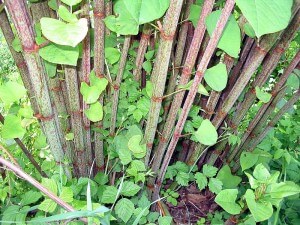
We have all seen this plant growing along stream beds and in wet areas. Japanese Knotweed (Polygonum cuspidatum / Fallopia japonica) is native to… you guessed it, Japan. It’s also native to other parts of Asia. This plant has naturalized in many parts of the world, it grows in 39 of the 50 United States and is listed as one of the world’s worst 100 invasive plant species by the World Conservation Union. In other words there is no guilt in cutting down a Japanese Knotweed grove just to eat a few stalks. Another common name for this plant is Japanese Bamboo, because it grows with nodes similar to bamboo although it is not a bamboo.
Edibility and Culinary Use

Japanese Knotweed is a favorite wild edible to many people around the world because it is so easy to harvest and identify, and it tastes so good. The stems can be eaten either raw or cooked when they are still juicy in the early spring, they get too tough to eat as the season progresses. The taste is similar to rhubarb, sour and tart. It can be used as a rhubarb substitute in pies.
Health Benefits
The nutritional benefits of Japanese knotweed are that it contains vitamin A, vitamin C, potassium, phosphorus, zinc, and manganese. It also contains resveratrol which is a substance still being studied for its numerous health benefits.
Key ID Features
Japanese Knotweet spreads by runners which send up stalks that can reach about 6′ in height. The stalks are segmented by nodes every 6″-8″ similar to bamboo. There are 2 types of new growth in the spring, seed growth and runner growth. Seedlings are small and thin. New stalks originating from runner roots come up about 1″-1.5″ stem diameter, and they grow very quickly, these are the stalks that are usually eaten.
Video on How to Identify Japanese Knotweed
Cautions
Japanese Knotweed contains oxalic acid just like rhubarb, spinach and some other common vegetables. Oxalic Acid aggravates conditions such as rheumatism, arthritis, gout, kidney stones or hyperacidity. So if your doctor has told you to avoid oxalic acid then avoid Japanese Knotweed.
Conclusion

This is a plant that can be harvested in large quantities. So unless your limiting your oxalic acid intake this plant should be part of everyone’s diet, it’s easy to find, identify, harvest, very good for you, and it tastes great. So next time you see Japanese Knotweed growing in a clean streambed in early spring think about taking some home.
Many of our readers find that subscribing to Eat The Planet is the best way to make sure they don't miss any of our valuable information about wild edibles.
See our privacy policy for more information about ads on this site






